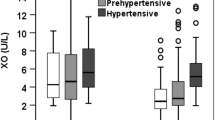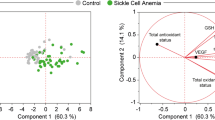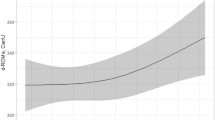Abstract
To investigate the total antioxidant status (TAS) and the extent of oxidative DNA damage in total lymphocytes and their relation with essential hypertension. A total of 130 South Indian subjects aged 30–65 were recruited for the study. Of these hypertensive subjects investigated, 30 were newly diagnosed and were not on any antihypertensive drugs, but had systolic blood pressure (BP) ranging between 140 and 160 mm Hg and diastolic BP between 95 and 100 mm Hg; 50 hypertensive patients who were already on drug therapy for 1 year and 50 were normotensive controls with BP ⩽120/80 mm Hg. DNA damage was significantly increased in hypertensive patients (both newly diagnosed and who were already on drug therapy) compared with control group. The major increase in DNA damage was observed in newly diagnosed hypertensive patients compared with hypertensive patients who were already on drug therapy. There was a significant decrease in plasma TAS value in essential hypertensive groups as compared to normotensive controls. Lymphocyte DNA damage was independently correlated with only TAS. Lymphocyte DNA damage was increased in hypertensive patients. The major increase in lymphocyte DNA damage was observed in newly diagnosed hypertensive patients compared with hypertensive patients who already on drug therapy. Decreased TAS levels, which reflect to increased oxidative stress, may be the reason of increased total lymphocyte DNA damage in South Indian hypertensive patients.
This is a preview of subscription content, access via your institution
Access options
Subscribe to this journal
Receive 12 digital issues and online access to articles
$119.00 per year
only $9.92 per issue
Buy this article
- Purchase on Springer Link
- Instant access to full article PDF
Prices may be subject to local taxes which are calculated during checkout




Similar content being viewed by others
References
Chobanian AV, Bakris GL, Black HR, Cushman WC, Green LA, Izzo JL Jr et al. National Heart, Lung, and Blood Institute Joint National Committee on prevention, detection, evaluation, and treatment of high blood pressure; National High Blood Pressure Education Program Coordinating Committee. The seventh report of the Joint National Committee on prevention, detection, evaluation, and treatment of high blood pressure. The JNC 7 report. JAMA 2003; 289: 2560–2572.
Makazono K, Watanabe N, Matsuno K, Sasaki J, Sato T, Inow M . Does superoxide underlie the pathogenesis of hypertension? Proc Natl Acad Sci USA 1991; 88: 10045–10048.
De Bruyn VH, Nuns DW, Cappelli-Biggazzi M, Dole WR, Lamping KG . Effect of acute hypertension in the coronary vessels. J Hypertens 1994; 12: 163–172.
Hartmann A, Herkommer K, Gluck M, Speit G . DNA damaging effect of cyclophosphamide on human blood cells in vivo and in vitro studied with the single cell gel test (comet-assay), environ. Mol Mutagen 1995; 25: 180–187.
Awara WM, El-Nabi SH, El-Gohary M . Assessment of vinyl chloride-induced DNA damage in lymphocytes of plastic industry workers using a single cell gel electrophoresis technique. Toxicology 1998; 128: 9–16.
Halliwell B, Aruoma O . DNA damage by oxygen-derived species: its mechanism and measurement in mammalian systems. FEBS Lett 1991; 281: 9–19.
Ames BN . Endogenous DNA damage as related to cancer and ageing. Free Radic Res Commun 1989; 7: 121–128.
Botto N, Rizza A, Colombo MG, Mazzone AM, Manfredi S, Masetti S et al. Evidence for DNA damage in patients with coronary artery disease. Mutat Res 2001; 493: 23–30.
Schottenfeld D, Beebe-Dimmer J . Chronic inflammation: a common and important factor in the pathogenesis of neoplasia. CA Cancer J Clin 2006; 56: 69–83.
Demirbag R, Yilmaz R, Kocyigit A . Relationship between DNA damage, total antioxidant capacity and coronary artery disease. Mutat Res 2005; 570: 197–203.
Romero JC, Reckelhoff JF . Role of angiotensin and oxidative stress in essential hypertension. Hypertension 1999; 34: 943–949.
Chandha SL, Radha Krishnan S, Ramachandran K, Kaul V, Gopinath N . Prevalence, awareness and treatment status of hypertension in urban population of Delhi. Indian J Med Res 1990; 92: 233–240.
Singh PN, McCoy MT, Tice RR, Schneider EL . A simple technique for quantitation of low levels of DNA damage in individual cells. Exp Cell Res 1988; 175: 184–191.
Burlinson B, Tice RR, Speit G, Agurell E, Brendler-Schwaab SY, Collins AR et al. Fouth International Workshop on Genotoxicity testing: results of the in vivo Comet assay workgroup. Mutat Res 2007; 627: 31–35.
Iris Benzie EF . Ferric reducing antioxidant power assay. Direct measure of total antioxidant activity of biological fluids and modified version for simultaneous measurement of total antioxidant power and ascorbic acid concentration. Methods Enzymol 1996; 299: 15–27.
Erdogan C . The evaluation of oxidative stress in patients with CRF. Clin Chim Acta 2002; 322: 157–167.
Benzie IF, Strain JJ . The ferric reducing ability of plasma (FRAP) as a measure of ‘antioxidant power’. The FRAP assay. Anal Biochem 1996; 239: 70–76.
Steinberg D, Witztum JL . Is the oxidative modification hypothesis relevant to human atherosclerosis? Do the antioxidant trials conducted to date refute the hypothesis? Circulation 2002; 105: 2107–2111.
Chisolm GM, Steinberg D . The oxidative modification hypothesis of atherogenesis: an overview. Free Radic Biol Med 2000; 28: 1815–1826.
Russo C, Olivieri O, Girelli D, Faccini G, Zenari ML, Lombardi S et al. Anti-oxidant status and lipid peroxidation in patients with essential hypertension. J Hypertens 1998; 16: 1267–1271.
Prabha PS, Das UN, Koratkar R, Sagar PS, Ramesh G . Free radical generation, lipid peroxidation and essential fatty acids in uncontrolled essential hypertension. Prostaglandins Leukot Essent Fatty Acids 1990; 41: 27–33.
Halliwell B, Aruoma O . DNA damage by oxygen-derived species: its mechanism and measurement in mammalian systems. FEBS Lett 1991; 281: 9–19.
Chen LY, Nichols WW, Hendricks J, Mehta JL . Myocardial neutrophil infiltration, lipid peroxidation, and antioxidant activity after coronary artery thrombosis and thrombolysis. Am Heart J 1995; 129: 211–218.
Honda M, Yamada Y, Tomonaga M, Ichinose H, Kamihira S . Correlation of urinary 8-hydroxy-2- de-oxyguanosine (8-OHdG), a biomarker of oxidative DNA damage, and clinical features of hematological disorders: a pilot study. Leuk Res 2000; 24: 461–468.
Wayner DD, Burton GW, Ingold KU . The antioxidant efficiency of vitamin C is concentration-dependent. Biochim Biophys Acta 1986; 884: 119–123.
Touyz RM, Tabet F, Schiffrin EL . Redox-dependent signalling by angiotensin II and vascular remodelling in hypertension. Clin Exp Pharmacol Physiol 2003; 30: 860–866.
Diep QN, Amiri F, Touyz RM, Cohn JS, Endemann D, Neves MF et al. PPARalpha activator effects on Ang II-induced vascular oxidative stress and inflammation. Hypertension 2002; 40: 866–871.
Taniyama Y, Griendling KK . Reactive oxygen species in the vasculature: molecular and cellular mechanisms. Hypertension 2003; 42: 1075–1081.
Jialal I, Devaraj S . Antioxidants and atherosclerosis: don't throw out the baby with the bath water. Circulation 2003; 107: 926–928.
Patterson C, Madamanchi NR, Runge MS . The oxidative paradox: another piece in the puzzle. Circ Res 2000; 87: 1074–1076.
Nishiyama A, Yao L, Nagai Y, Miyata K, Yoshizumi M, Kagami S et al. Possible contributions of reactive oxygen species and mitogen-activated protein kinase to renal injury in aldosterone/salt-induced hypertensive rats. Hypertension 2004; 43: 841–848.
Virdis A, Fritsch Neves M, Amiri F, Viel E, Touyz RM, Schiffrin EL . Spironolactone improves angiotensin-induced vascular changes and oxidative stress. Hypertension 2002; 40: 504–510.
Dobrian AD, Schriver SD, Khraibi AA, Prewitt RL . Pioglitazone prevents hypertension and reduces oxidative stress in diet-induced obesity. Hypertension 2004; 43: 48–56.
Author information
Authors and Affiliations
Corresponding author
Ethics declarations
Competing interests
The authors declare no conflict of interest.
Rights and permissions
About this article
Cite this article
Subash, P., Premagurumurthy, K., Sarasabharathi, A. et al. Total antioxidant status and oxidative DNA damage in a South Indian population of essential hypertensives. J Hum Hypertens 24, 475–482 (2010). https://doi.org/10.1038/jhh.2009.100
Received:
Revised:
Accepted:
Published:
Issue Date:
DOI: https://doi.org/10.1038/jhh.2009.100
Keywords
This article is cited by
-
Race/ethnicity determines the relationships between oxidative stress markers and blood pressure in individuals with high cardiovascular disease risk
Journal of Human Hypertension (2017)
-
DNA damage and oxidative status in newly diagnosed, untreated, dipper and non-dipper hypertensive patients
Hypertension Research (2013)
-
DNA damage clue to hypertension
Nature India (2010)



